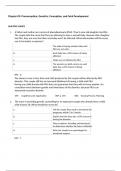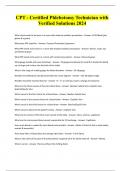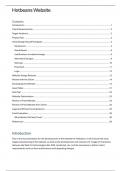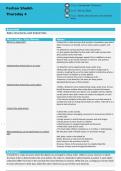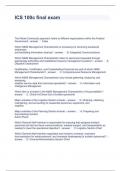Chapter 09: Preconception, Genetics, Conception, and Fetal Development
MULTIPLE CHOICE
1. A father and mother are carriers of phenylketonuria (PKU). Their 2-year-old daughter has PKU.
The couple tells the nurse that they are planning to have a second baby. Because their daughter
has PKU, they are sure that their next baby won’t be affected. What information will the nurse
use to formulate a response?
The odds of having another baby with
PKU are very slim.
b. Each baby has a 50% chance of being
affected.
c. Males are not affected by PKU.
d. The parents are both carriers so each
baby has a 25% chance of being
affected.
ANS: D
The chance is one in four that each child produced by this couple will be affected by PKU
disorder. This couple still has an increased likelihood of having a child with PKU.
Having one child already with PKU does not guarantee that they will not have another. No
correlation exists between gender and inheritance of the disorder, because PKU is an
autosomal recessive disorder.
DIF: Cognitive Level: Application REF: p. 184 OBJ: Nursing Process: Planning
2. The nurse is providing genetic counselling for an expectant couple who already have a child
with trisomy 18. What should the nurse do?
a. Tell the couple they need to terminate the
pregnancy within 2 to 3 weeks.
b. Explain that the fetus has a 50% chance of
having the disorder.
c. Discuss options, including amniocentesis,
to determine whether the fetus is affected.
d. Refer the couple to a psychologist for
emotional support.
ANS: C
, a.
Genetic testing, including amniocentesis, would need to be performed to determine whether
the fetus is affected. The couple should be given information about the likelihood of having
another baby with this disorder so that they can make an informed decision. A genetic
counsellor is the best source for determining genetic probability ratios. The couple eventually
may need emotional support, but the status of the pregnancy must be determined first.
DIF: Cognitive Level: Comprehension REF: p. 182 | p. 185 | p. 192
OBJ: Nursing Process: Planning | Nursing Process: Implementation
3. The nurse is assessing the knowledge of new parents with a child born with maple syrup urine
disease (MSUD). Which is accurate related to MSUD?
Both genes of a pair must be abnormal for
the disorder to be present.
b. Only one copy of the abnormal gene is
required for the disorder to be present.
c. The disorder occurs in males and
heterozygous females.
d. The disorder is carried on the X
chromosome.
ANS: A
MSUD is a type of autosomal recessive inheritance disorder in which both genes of a pair must
be abnormal for the disorder to be expressed. MSUD is not an X-linked dominant disorder.
MSUD is not a recessive disorder. MSUD is not an autosomal dominant inheritance disorder.
DIF: Cognitive Level: Comprehension REF: p. 184
OBJ: Nursing Process: Assessment
4. During a presentation to obstetrical nurses interested in genetics, what does the genetic nurse
identify as the primary factor to consider with genetic testing?
a. Anxiety and altered family relationships
b. Accessibility related to the availability of
genetic testing
c. High false-positive rates associated with
genetic testing
d. Ethnic and socioeconomic disparity
associated with genetic testing
ANS: B
Decisions about genetic testing are shaped by accessibility of available genetic testing. The
geographic location where the woman receives prenatal care and social norms are the primary
, a.
Occurrence risk
b. Recurrence risk
c. Predictive testing
d. Predisposition testing
ANS: B
factors to consider. Smaller rural communities in Canada do not offer the array of choices
available in larger urban centres. Anxiety and altered family relationships, high false-positive
rates, and ethnic and socioeconomic disparity are factors that may be difficulties associated
with genetic testing, but they are not risks associated with testing.
DIF: Cognitive Level: Comprehension REF: p. 180
OBJ: Nursing Process: Implementation
5. A man’s wife is pregnant for the third time. One child was born with cystic fibrosis and the
other child is healthy. The man wonders what the chance is that this child will have cystic
fibrosis.
What is this type of testing known as?
The couple already has a child with a genetic disease; therefore, they will be given a recurrence
risk test. If a couple has not yet had children but are known to be at risk for having children
with a genetic disease, they are given an occurrence risk test. Predictive testing is used to
clarify the genetic status of an asymptomatic family member. Predisposition testing differs from
presymptomatic testing in that a positive result does not indicate 100% risk of a condition
developing.
DIF: Cognitive Level: Comprehension REF: p. 186 OBJ: Nursing Process: Planning
6. A couple has been counselled for genetic anomalies. They ask you, “What is karyotyping?” The
nurse’s response is based on which information related to karyotyping?
a. It will provide the status of lung maturity.
b. It is a predictor of normal fetal
development.
c. It identifies fetal gender and chromosomal
information.
d. It can detect physical deformities.
ANS: C
Karyotyping provides genetic information such as gender and chromosome structure.
The lecithin-to-sphingomyelin (L/S) ratio, not karyotyping, reveals lung maturity. Although
karyotyping can detect genetic anomalies, the range of normal is nondescriptive. Although
karyotyping can detect genetic anomalies, not all such anomalies display obvious physical
MULTIPLE CHOICE
1. A father and mother are carriers of phenylketonuria (PKU). Their 2-year-old daughter has PKU.
The couple tells the nurse that they are planning to have a second baby. Because their daughter
has PKU, they are sure that their next baby won’t be affected. What information will the nurse
use to formulate a response?
The odds of having another baby with
PKU are very slim.
b. Each baby has a 50% chance of being
affected.
c. Males are not affected by PKU.
d. The parents are both carriers so each
baby has a 25% chance of being
affected.
ANS: D
The chance is one in four that each child produced by this couple will be affected by PKU
disorder. This couple still has an increased likelihood of having a child with PKU.
Having one child already with PKU does not guarantee that they will not have another. No
correlation exists between gender and inheritance of the disorder, because PKU is an
autosomal recessive disorder.
DIF: Cognitive Level: Application REF: p. 184 OBJ: Nursing Process: Planning
2. The nurse is providing genetic counselling for an expectant couple who already have a child
with trisomy 18. What should the nurse do?
a. Tell the couple they need to terminate the
pregnancy within 2 to 3 weeks.
b. Explain that the fetus has a 50% chance of
having the disorder.
c. Discuss options, including amniocentesis,
to determine whether the fetus is affected.
d. Refer the couple to a psychologist for
emotional support.
ANS: C
, a.
Genetic testing, including amniocentesis, would need to be performed to determine whether
the fetus is affected. The couple should be given information about the likelihood of having
another baby with this disorder so that they can make an informed decision. A genetic
counsellor is the best source for determining genetic probability ratios. The couple eventually
may need emotional support, but the status of the pregnancy must be determined first.
DIF: Cognitive Level: Comprehension REF: p. 182 | p. 185 | p. 192
OBJ: Nursing Process: Planning | Nursing Process: Implementation
3. The nurse is assessing the knowledge of new parents with a child born with maple syrup urine
disease (MSUD). Which is accurate related to MSUD?
Both genes of a pair must be abnormal for
the disorder to be present.
b. Only one copy of the abnormal gene is
required for the disorder to be present.
c. The disorder occurs in males and
heterozygous females.
d. The disorder is carried on the X
chromosome.
ANS: A
MSUD is a type of autosomal recessive inheritance disorder in which both genes of a pair must
be abnormal for the disorder to be expressed. MSUD is not an X-linked dominant disorder.
MSUD is not a recessive disorder. MSUD is not an autosomal dominant inheritance disorder.
DIF: Cognitive Level: Comprehension REF: p. 184
OBJ: Nursing Process: Assessment
4. During a presentation to obstetrical nurses interested in genetics, what does the genetic nurse
identify as the primary factor to consider with genetic testing?
a. Anxiety and altered family relationships
b. Accessibility related to the availability of
genetic testing
c. High false-positive rates associated with
genetic testing
d. Ethnic and socioeconomic disparity
associated with genetic testing
ANS: B
Decisions about genetic testing are shaped by accessibility of available genetic testing. The
geographic location where the woman receives prenatal care and social norms are the primary
, a.
Occurrence risk
b. Recurrence risk
c. Predictive testing
d. Predisposition testing
ANS: B
factors to consider. Smaller rural communities in Canada do not offer the array of choices
available in larger urban centres. Anxiety and altered family relationships, high false-positive
rates, and ethnic and socioeconomic disparity are factors that may be difficulties associated
with genetic testing, but they are not risks associated with testing.
DIF: Cognitive Level: Comprehension REF: p. 180
OBJ: Nursing Process: Implementation
5. A man’s wife is pregnant for the third time. One child was born with cystic fibrosis and the
other child is healthy. The man wonders what the chance is that this child will have cystic
fibrosis.
What is this type of testing known as?
The couple already has a child with a genetic disease; therefore, they will be given a recurrence
risk test. If a couple has not yet had children but are known to be at risk for having children
with a genetic disease, they are given an occurrence risk test. Predictive testing is used to
clarify the genetic status of an asymptomatic family member. Predisposition testing differs from
presymptomatic testing in that a positive result does not indicate 100% risk of a condition
developing.
DIF: Cognitive Level: Comprehension REF: p. 186 OBJ: Nursing Process: Planning
6. A couple has been counselled for genetic anomalies. They ask you, “What is karyotyping?” The
nurse’s response is based on which information related to karyotyping?
a. It will provide the status of lung maturity.
b. It is a predictor of normal fetal
development.
c. It identifies fetal gender and chromosomal
information.
d. It can detect physical deformities.
ANS: C
Karyotyping provides genetic information such as gender and chromosome structure.
The lecithin-to-sphingomyelin (L/S) ratio, not karyotyping, reveals lung maturity. Although
karyotyping can detect genetic anomalies, the range of normal is nondescriptive. Although
karyotyping can detect genetic anomalies, not all such anomalies display obvious physical

